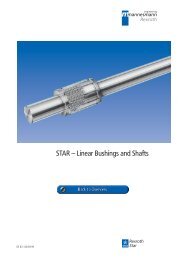STAR – Precision Ball Screw Assemblies
STAR – Precision Ball Screw Assemblies
STAR – Precision Ball Screw Assemblies
You also want an ePaper? Increase the reach of your titles
YUMPU automatically turns print PDFs into web optimized ePapers that Google loves.
<strong>STAR</strong> <strong>–</strong> <strong>Precision</strong> <strong>Ball</strong> <strong>Screw</strong> <strong>Assemblies</strong><br />
Lubrication<br />
Standard lubrication practices for ball<br />
bearings also apply to ball screws.<br />
Lubricant loss is, however, greater than<br />
that of ball bearings due to the axial<br />
motion between the screw and the nut.<br />
Oil lubrication<br />
The influence of the temperature on the<br />
performance of the ball screw is very<br />
significant, as the thermal expansion of<br />
the ball screw interferes with the positioning<br />
accuracy of the assembly.<br />
One of the advantages of oil lubrication<br />
over grease lubrication is therefore the<br />
minimized heat build-up of the ball screw,<br />
particularly at high speeds.<br />
As a rule, commercially available mineral<br />
base oils used for ball bearings are<br />
suitable. The necessary viscosity depends<br />
on the speed, temperature and load<br />
conditions of the respective application<br />
(see DIN 51501, 51517, 51519 and GfT<br />
Worksheet 3).<br />
Oils ranging from ISO VG 68 to approx.<br />
ISO VG 460 are used in practice. The high<br />
viscosity grades (e.g. ISO VG 460) should<br />
be preferred in general and particularly for<br />
slow running screws. A maximum<br />
relubrication interval of up to 10 operating<br />
hours can be attained with small quantities<br />
from the table along side.<br />
Grease lubrication<br />
The advantage of grease lubrication is that<br />
the ball screw can run long distances on<br />
one supply of grease. As a result, a<br />
lubricating system is not required in many<br />
cases. The amount of grease used should<br />
fill the nuts to approximately half of their<br />
capacity.<br />
All commercially available ball bearing<br />
lubricating greases may be used. Read the<br />
lubricant manufacturer’s specifications<br />
carefully! Never use greases with solid<br />
lubricant components<br />
(e.g. graphite or MoS2 ).<br />
Relubrication quantity and intervals for oil<br />
do Initial Relubrication Revo- Travel (km)<br />
oil supply oil lutions with lead P =<br />
V (ml) e V (ml)/10h n U (Mio) 5 10 16 20 25 32 40<br />
8 0.300 0.030 1.3 7 13 21 26 33 42 52<br />
12 0.300 0.030 1.3 7 13 21 26 33 42 52<br />
16 0.300 0.030 1.3 7 13 21 26 33 42 52<br />
20 0.600 0.060 1.0 5 10 16 20 25 32 40<br />
25 0.600 0.060 1.0 5 10 16 20 25 32 40<br />
32 0.600 0.060 1.0 5 10 16 20 25 32 40<br />
40 2.000 0.400 1.0 5 10 16 20 25 32 40<br />
50 4.000 0.800 1.0 5 10 16 20 25 32 40<br />
63 4.000 0.800 1.0 5 10 16 20 25 32 40<br />
d0 = nominal diameter<br />
Relubrication intervals for NLGI 2 greases<br />
d0 Revo- travel (km)<br />
Relubrication quantity,<br />
lutions with lead P =<br />
see table for NLGI 2 greases<br />
U (Mio) 5 10 16 20 25 32 40<br />
≤ 40 50 250 500 800 1000 1250 1600 2000<br />
> 40 10 50 100 160 200 250 320 400<br />
d 0 = nominal diameter<br />
Limit conditions:<br />
Load = ≤ 0.2 C<br />
nmin = 100 min-1 Tempmax. nut = 80 °C<br />
Tempcontinuous nut = 60 °C<br />
Greases in accordance with DIN 51825<br />
K2K and, for higher loads, KP2K of NLGI<br />
Class 2 according to DIN 51818 are<br />
recommended for the longest possible<br />
lubrication intervals. Tests have proven<br />
that greases of NLGI Class 00 achieve only<br />
about 50% of the running performance of<br />
Class 2 greases at high loads.<br />
The lubrication interval depends on many<br />
factors such as the degree of contamination,<br />
operating temperature, load, etc. The<br />
following values can thus serve only as a<br />
guideline.<br />
Set-up: - any<br />
Operating mode: - driven screw<br />
- no short stroking<br />
or hypercritical<br />
operation<br />
Sealing: - standard<br />
92 RE 83 301/12.99



